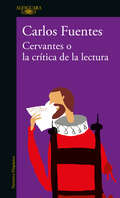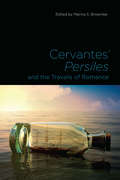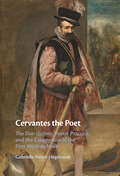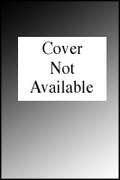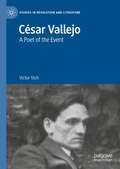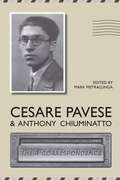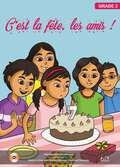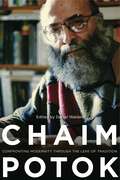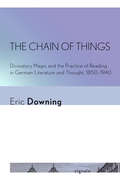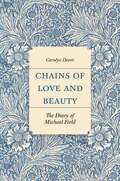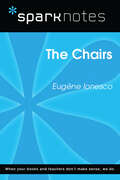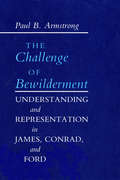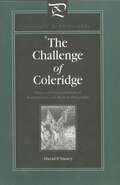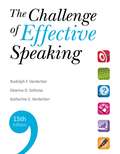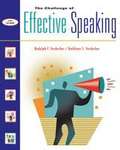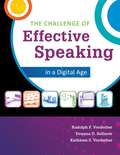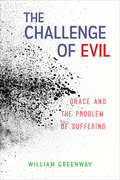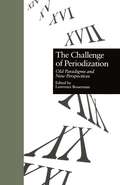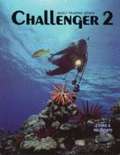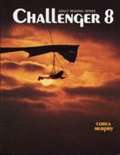- Table View
- List View
Cervantes' Epic Novel
by Michael Armstrong-RocheMiguel de Cervantes conceived his final work, The Labours of Persiles and Sigismunda: A Northern Story (1617), as a great prose epic that would accomplish for its age what Homer and Virgil had done for theirs. And yet, by the eighteenth century Don Quixote had eclipsed Persiles in the favour of readers and writers alike and the later novel is now virtually forgotten except by specialists. This study sets out to help restore Persiles to pride of place within Cervantes's corpus by reading it as the author's summa, as a boldly new kind of prose epic that casts an original light on the major political, religious, social, and literary debates of its era. At the same time it seeks to illuminate how such a lofty and solemn ambition could coexist with Cervantes evident urge to delight. Grounded in the novel's multiple contexts - literature, history and politics, philosophy and theology - and in close reading of the text, Michael Armstrong-Roche aims to reshape our understanding of Persiles within the history of prose fiction and to take part in the ongoing conversation about the relationship between literary and non-literary cultural forms. Ultimately he reveals how Cervantes recast the prose epic, expanding it in new directions to accommodate the great epic themes - politics, love, and religion - to the most urgent concerns of his day.
Cervantes, Literature and the Discourse of Politics
by Anthony J. CascardiWhat is the role of literature in the formation of the state? Anthony J. Cascardi takes up this fundamental question in Cervantes, Literature, and the Discourse of Politics, a comprehensive analysis of the presence of politics in Don Quixote. Cascardi argues that when public speech is constrained, as it was in seventeenth-century Spain, politics must be addressed through indirect forms including comedy, myth, and travellers' tales.Cervantes, Literature, and the Discourse of Politics convincingly re-engages the ancient roots of political theory in modern literature by situating Cervantes within a long line of political thinkers. Cascardi notably connects Cervantes's political theory to Plato's, much as the writer's literary criticism has been firmly linked to Aristotle's. He also shows how Cervantes's view of literature provided a compelling alternative to the modern, scientific politics of Machiavelli and Hobbes, highlighting the potential interplay of literature and politics in an ideal state.
Cervantes o la crítica de la lectura
by Carlos Fuentes«Don Quijote, el loco, está loco no sólo porque ha creído lo que ha leído. También está loco porque cree, como caballero andante, que la justicia es su deber y que la justicia es posible.» Desde Zona sagrada hasta Terra Nostra, la narrativa de CarlosFuentes oscilaba entre la sobriedad en el relato y la obra como una broma que asaltaba la realidad para trastocarla. En su discurso de ingreso en El Colegio Nacional hizo ver la similitud de obras totalizantes, como Don Quijote de la Mancha de Miguel de Cervantes y Finnegans Wake de James Joyce.Discurso que se extiende, retrocede y avanza en estos ensayos que incitan a revisar y releer estas y otras obras que rompen la realidad e inventan una nueva, alterna y paralela, pero llena de rebelión, que resaltan sus características y nos hacen ver el mundo con otros ojos; por ejemplo, el Quijote desde antes de ser escrito, revisado en su época y a lo largo de su existencia, en su España árabe y judía y ya contaminada del Nuevo Mundo, con sus personajes reales y ficticios que salen de otros libros y asaltan otras literaturas. Una incitación a la lectura rebelde, y a rebelarse, con una fantasía que es mejor y más vital que cualquier realidad posible.
Cervantes' Persiles and the Travails of Romance (Toronto Iberic)
by Marina S. BrownleeThis collection of original essays presents new ways of looking at Cervantes’ final novel. Persiles, a work that engages with geopolitical models of race, ethnicity, nation, and religion, takes its inspiration from the highly influential Ethiopian Story (the Aithiopika) of Heliodorus. With particular relevance to the period, Persiles questions the issue of cultural pluralism in the Spanish empire and emphasizes the need to rethink the radically altered category of lo bárbaro/the barbarian (which included not only the Jew, the Muslim, and the Gypsy, but also the criollo, the mestizo, and the indiano), a new multiracial and multiethnic reality that posed a profound challenge to early modern Spain. The contributors offer a range of perspectives in spatial theory, psychology and subjectivity, visual culture, and literary theory.
Cervantes the Poet: The Don Quijote, Poetic Practice, and the Conception of the First Modern Novel
by Gabrielle Ponce-HegenauerCervantes the Poet travels from the court of Isabel de Valois to Rome, Naples, Palermo, Algiers, and Madrid's barrio de las letras. Recovering Cervantes' nearly forty-year literary career before the publication of Don Quijote, Gabrielle Ponce-Hegenauer demonstrates the cultural, literary, and theoretical significance of Cervantes' status as a late-sixteenth-century itinerant poet. This study recovers the generative literary milieus and cultural practices of Spain's most famous novelist in order to posit a new theory of the modern novel as an organic transformation of lyric practices native to the late-sixteenth century and Cervantes' own literary outlook.
Cervantine Blackness (Iberian Encounter and Exchange, 475–1755)
by Nicholas R. JonesThere is no shortage of Black characters in Miguel de Cervantes’s works, yet there has been a profound silence about the Spanish author’s compelling literary construction and cultural codification of Black Africans and sub-Saharan Africa. In Cervantine Blackness, Nicholas R. Jones reconsiders in what sense Black subjects possess an inherent value within Cervantes’s cultural purview and literary corpus.In this unflinching critique, Jones charts important new methodological and theoretical terrain, problematizing the ways emphasis on agency has stifled and truncated the study of Black Africans and their descendants in early modern Spanish cultural and literary production. Through the lens of what he calls “Cervantine Blackness,” Jones challenges the reader to think about the blind faith that has been lent to the idea of agency—and its analogues “presence” and “resistance”—as a primary motivation for examining the lives of Black people during this period. Offering a well-crafted and sharp critique, through a systematic deconstruction of deeply rooted prejudices, Jones establishes a solid foundation for the development of a new genre of literary and cultural criticism. A searing work of literary criticism and political debate, Cervantine Blackness speaks to specialists and nonspecialists alike—anyone with a serious interest in Cervantes’s work who takes seriously a critical reckoning with the cultural, historical, and literary legacies of agency, antiblackness, and refusal within the Iberian Peninsula and the global reaches of its empire.
César Vallejo: A Poet of the Event (Studies in Revolution and Literature)
by Víctor VichThis book argues that the poetry of César Vallejo announces the event, as a moment of irruption of a truth that destabilises the usual state of reality. It studies the emergence of a subject who affirms a truth that exceeds the law, interrupts hegemonic repetition, asserts universal solidarity, and defends "lost causes" despite political failure. The author reconfigures the traditional reading of Vallejo only as a poet of pain and human suffering, and offers new ways of understanding the relationship between poetry and politics.
Cesare Pavese and Antonio Chiuminatto: Their Correspondence (The Royal Society of Canada Special Publications)
by Mark PietralungaItalian poet, novelist, literary critic and translator Cesare Pavese (1908-1950) is generally recognized as one of the most important writers of his period. Between the years 1929 and 1933, Pavese enjoyed a rich correspondence with his Italian American friend, the musician and educator Antonio Chiuminatto (1904-1973). The nature of this correspondence is primarily related to Pavese's thirst to learn about American culture, its latest books, its most significant contemporary writers, as well as its slang. This volume presents an annotated edition of Pavese and Chiminatto's complete epistolary exchange.Mark Pietralunga's brilliant introduction provides historical and cultural context for the letters and traces Pavese's early development as a leading Americanist and translator. The volume also includes an appendix of Chiuminatto's detailed annotations and thorough explanations of colloquial American terms and slang, drawn from the works of Sinclair Lewis, Sherwood Anderson, and William Faulkner. A lively and illuminating exchange, this collection ultimately corroborates critical opinion that America was the igniting spark of Pavese's literary beginnings as a writer and translator.
C’est la fête, les amis! class 2 - MIE
by Kaviraj. S. PeedolyLe livre "C’est la fête, les amis!" rédigé par Kaviraj. S. Peedoly et illustré par William Rasoanaivo, est un récit captivant qui relate la joyeuse célébration de l'anniversaire d'Aaliya et de la Journée de l'Indépendance de l'île Maurice. L'histoire se déroule alors qu'Aaliya invite avec enthousiasme ses camarades de classe à se joindre à sa célébration, débutant par l'hymne national dans le jardin, en commémoration de l'indépendance du pays. Le récit capte l'excitation de couper le gâteau d'anniversaire, de recevoir des cadeaux et de savourer de délicieuses gourmandises. Conçu comme un livre géant interactif, les sessions sont structurées de manière réfléchie, encourageant les discussions pré-lecture sur les thèmes de l'indépendance et des anniversaires. Les sessions engageantes du livre permettent aux élèves d'explorer la compréhension linguistique à travers des discussions de groupe, de se remémorer des expériences personnelles liées aux thèmes, et de favoriser des activités créatives telles que le coloriage. À travers des illustrations vibrantes et une narration accessible, le livre vise à promouvoir la littératie et la compréhension culturelle parmi les jeunes apprenants à Maurice, offrant une plateforme interactive pour renforcer les compétences linguistiques tout en célébrant des événements précieux.
Chaim Potok: Confronting Modernity Through the Lens of Tradition
by Daniel WaldenChaim Potok was a world-class writer and scholar, a Conservative Jew who wrote from and about his tradition and the conflicts between observance and acculturation. With a plain, straightforward style, his novels were set against the moral, spiritual, and intellectual currents of the twentieth century. This collection aims to widen the lens through which we read Chaim Potok and to establish him as an authentic American writer who created unforgettable characters forging American identities for themselves while retaining their Jewish nature. The essays illuminate the central struggle in Potok’s novels, which results from a profound desire to reconcile the appeal of modernity with the pull of traditional Judaism. The volume includes a memoir by Adena Potok and ends with Chaim Potok’s “My Life as a Writer,” a speech he gave at Penn State in 1982.Aside from the editor, the contributors are Victoria Aarons, Nathan P. Devir, Jane Eisner, Susanne Klingenstein, S. Lillian Kremer, Jessica Lang, Sanford E. Marovitz, Kathryn McClymond, Hugh Nissenson, Adena Potok, and Jonathan Rosen.
Chaim Potok: Confronting Modernity Through the Lens of Tradition
by Daniel WaldenChaim Potok was a world-class writer and scholar, a Conservative Jew who wrote from and about his tradition and the conflicts between observance and acculturation. With a plain, straightforward style, his novels were set against the moral, spiritual, and intellectual currents of the twentieth century. This collection aims to widen the lens through which we read Chaim Potok and to establish him as an authentic American writer who created unforgettable characters forging American identities for themselves while retaining their Jewish nature. The essays illuminate the central struggle in Potok’s novels, which results from a profound desire to reconcile the appeal of modernity with the pull of traditional Judaism. The volume includes a memoir by Adena Potok and ends with Chaim Potok’s “My Life as a Writer,” a speech he gave at Penn State in 1982.Aside from the editor, the contributors are Victoria Aarons, Nathan P. Devir, Jane Eisner, Susanne Klingenstein, S. Lillian Kremer, Jessica Lang, Sanford E. Marovitz, Kathryn McClymond, Hugh Nissenson, Adena Potok, and Jonathan Rosen.
Chain 7: memoir/anti-memoir
by Juliana Spahr Jena OsmanMemoir/Antimemoir presents new works that show the expanse and range of contemporary memoir. The works gathered here reveal memoir as re-invention, as generic interplay, as conversations among works, as travel back and forth and across times and states of mind. One can see in these works the political and psychic stakes involved in self-representation. Features work by C. S. Giscombe, Lisa Jarnot, Shirin Neshat, Edwin Torres, Ron Silliman, Anne Waldman, and Rosmarie Waldrop.
The Chain of Things: Divinatory Magic and the Practice of Reading in German Literature and Thought, 1850–1940 (Signale: Modern German Letters, Cultures, and Thought)
by Eric DowningIn The Chain of Things, Eric Downing shows how the connection between divinatory magic and reading shaped the experience of reading and aesthetics among nineteenth-century realists and modernist thinkers. He explores how writers, artists, and critics such as Gottfried Keller, Theodor Fontane, and Walter Benjamin drew on the ancient practice of divination, connecting the Greek idea of sympathetic magic to the German aesthetic concept of the attunement of mood and atmosphere.Downing deftly traces the genealogical connection between reading and art in classical antiquity, nineteenth-century realism, and modernism, attending to the ways in which the modern re-enchantment of the world—both in nature and human society—consciously engaged ancient practices that aimed at preternatural prediction. Of particular significance to the argument presented in The Chain of Things is how the future figured into the reading of texts during this period, a time when the future as a narrative determinant or article of historical faith was losing its force. Elaborating a new theory of magic as a critical tool, Downing secures crucial links between the governing notions of time, world, the "real," and art.
Chains of Love and Beauty: The Diary of Michael Field
by Carolyn DeverWhy a monumental diary by an aunt and niece who published poetry together as &“Michael Field&”—and who were partners and lovers for decades—is one of the great unknown works of late-Victorian and early modernist literatureMichael Field, the renowned late-Victorian poet, was well known to be the pseudonym of Katharine Bradley (1846–1914) and her niece, Edith Cooper (1862–1913). Less well known is that for three decades, the women privately maintained a romantic relationship and kept a double diary, sharing the page as they shared a bed and eventually producing a 9,500-page, twenty-nine-volume story of love, life, and art in the fin de siècle. In Chains of Love and Beauty, the first book about the diary, Carolyn Dever makes the case for this work as a great unknown &“novel&” of the nineteenth century and as a bridge between George Eliot and Virginia Woolf, Victorian marriage plot and modernist experimentation.While Bradley and Cooper remained committed to publishing poetry under a single, male pseudonym, the diary, which they entitled Works and Days and hoped would be published after their deaths, allowed them to realize literary ambitions that were unfulfilled during their lifetime. The women also used the diary, which remains largely unpublished, to negotiate their art, desires, and frustrations, as well as their relationships with contemporary literary celebrities, including Robert Browning, Oscar Wilde, William Butler Yeats, and Walter Pater.Showing for the first time why Works and Days is a great experimental work of late-Victorian and early modernist writing, one that sheds startling new light on gender, sexuality, and authorship, Dever reveals how Bradley and Cooper wrote their shared life as art, and their art as life, on pages of intimacy that they wanted to share with the world.
The Chairs (SparkNotes Literature Guide Series)
by SparkNotesThe Chairs (SparkNotes Literature Guide) by Eugene Ionesco Making the reading experience fun! Created by Harvard students for students everywhere, SparkNotes is a new breed of study guide: smarter, better, faster.Geared to what today's students need to know, SparkNotes provides:chapter-by-chapter analysis explanations of key themes, motifs, and symbols a review quiz and essay topicsLively and accessible, these guides are perfect for late-night studying and writing papers.
The Challenge of Bewilderment: Understanding and Representation in James, Conrad, and Ford
by Paul B. ArmstrongThe Challenge of Bewilderment treats the epistemology of representation in major works by Henry James, Joseph Conrad, and Ford Madox Ford, attempting to explain how the novel turned away from its traditional concern with realistic representation and toward self-consciousness about the relation between knowing and narration. Paul B. Armstrong here addresses the pivotal thematic experience of "bewilderment," an experience that challenges the reader’s very sense of reality and that shows it to have no more certainty or stability than an interpretative construct. Through readings of The Sacred Fount and The Ambassadors by James, Lord Jim and Nostromo by Conrad, and The Good Soldier and Parade’s End by Ford, Armstrong examines how each writer dramatizes his understanding of the act of knowing. Armstrong demonstrates how the novelists’ attitudes toward the process of knowing inform experiments with representation, through which they thematize the relation between the understanding of a fictional world and everyday habits of perception. Finally, he considers how these experiments with the strategies of narration produce a heightened awareness of the process of interpretation.
The Challenge of Coleridge: Ethics and Interpretation in Romanticism and Modern Philosophy (Literature and Philosophy)
by David HaneyInterweaving past and present texts, The Challenge of Coleridge engages the British Romantic poet, critic, and philosopher Samuel Taylor Coleridge in a "conversation" (in Hans-Georg Gadamer’s sense) with philosophical thinkers today who share his interest in the relationship of interpretation to ethics and whose ideas can be both illuminated and challenged by Coleridge’s insights into and struggles with this relationship.In his philosophy, poetry, theology, and personal life, Coleridge revealed his concern with this issue, as it manifests itself in the relation between technical and ethical discourse, between fact and value, between self and other, and in the ethical function of aesthetic experience and the role of love in interpretation and ethical action.Relying on Gadamer’s hermeneutics to supply a framework for his approach, Haney connects Coleridge’s ideas with, among others, Emmanuel Levinas’s other-oriented notion of ethical subjectivity, Paul Ricoeur’s view about the other’s implication in the self, reinterpretations of Greek drama by Bernard Williams and Martha Nussbaum, and Gianni Vattimo's post-Nietzschean hermeneutics.Coleridge is treated not as a product of Romantic ideology to be deconstructed from a modern perspective, but as a writer who offers a "challenge" to our modern tendency to compartmentalize interpretive issues as a concern for literary theorists and ethical issues as a concern for philosophers. Looking at the two together, Haney shows through his reading of Coleridge, can enrich our understanding of both.
The Challenge of Effective Speaking
by Rudolph F. Verderber Deanna D. Sellnow Kathleen S. VerderberDo you want to ace your public speaking course? All you need to know, including all of the skills that will help you become a confident speaker and conquer speaking anxiety, are thoroughly covered in THE CHALLENGE OF EFFECTIVE SPEAKING, 15e. A favorite with students, this best seller guides you through six key "Speech Planning Action Steps". The result? You'll learn how to prepare and deliver strong speeches that get you good grades in your public speaking course! You'll be guided through topic selection, audience analysis and adaptation, effective research (including appropriate use of Internet resources), organization (with an emphasis on outlining), and language and delivery. The new 15th edition of this nationwide best seller also including many online tools, including videos of actual student speeches accompanied by Interactive Video Activities that help you develop and strengthen your public speaking skills. Authors Rudy and Kathie Verderber, together with new coauthor Deanna D. Sellnow, have grounded this new edition with the latest research to give you an exceptional resource for creating and delivering your speeches.
The Challenge of Effective Speaking (12th edition)
by Rudolph F. Verderber Kathleen S. VerderberThis textbook introduces the skills of public speaking and applies them to work-related meetings, personal business transactions, and personal relationships. The authors describe how to develop confidence, listen effectively, analyze the audience, research information, organize ideas, practice delivery, and speak persuasively. Annotation ©2004 Book News, Inc., Portland, OR (book news.com)
The Challenge of Effective Speaking in a Digital Age (Sixteenth Edition)
by Rudolph F. Verderber Deanna D. Sellnow Kathleen S. VerderberAll the skills you need to know to become a confident speaker and conquer speaking anxiety are thoroughly covered in THE CHALLENGE OF EFFECTIVE SPEAKING IN A DIGITAL AGE, 16E. A pioneer in the field, this best seller guides you through six key Speech Planning Action Steps: topic selection, audience analysis and adaptation, effective research (including appropriate use of Internet resources), organization (with an emphasis on outlining), presentational aids (and how to avoid succumbing to "death by PowerPoint"), and language and delivery. The new edition also includes many online tools, such as videos of student speeches accompanied by Interactive Video Activities that help develop and strengthen public speaking skills. Grounded in the latest research, this new edition is an exceptional resource for creating and delivering speeches.
The Challenge of Evil: Grace And The Problem Of Suffering
by William GreenwayBelief in God in the face of suffering is one of the most intractable problems of Christian theology. Many respond to the spiritual challenge of evil by ignoring it, blaming God, or insisting on the inherent meaninglessness of life. In this book, William Greenway contends that we don't have to deny our moral selves by either ignoring evil or abandoning our moral sensibilities toward it. We can open our eyes fully to suffering and evil, and our own complicity in them. We can do so because it is only in this full acceptance of the world's guilt and our own that we make ourselves fully open to agape, to being seized by love of others and God. Inspired by the Jewish philosopher Emmanuel Levinas and the Christian novelist Fyodor Dostoyevsky, The Challenge of Evil lovingly explains how we can look squarely at the overwhelming suffering in the world and still, by grace, have faith in a good and loving God.
The Challenge of Periodization: Old Paradigms and New Perspectives
by Lawrence BessermanFirst published in 1996. Routledge is an imprint of Taylor & Francis, an informa company.
The Challenge of Rousseau
by Eve Grace Christopher KellyWritten by prominent scholars of Jean-Jacques Rousseau's philosophy, this collection celebrates the 300th anniversary of Rousseau's birth and the 250th anniversary of the publication of Emile. The depth and systematic character of Rousseau's thought was recognized almost immediately by thinkers such as Kant and Hegel, yet debate continues over the degree to which Rousseau's legacy is the result of poetic, literary, or rhetorical genius, rather than of philosophic rigor or profundity. The authors focus on Rousseau's genuine yet undervalued stature as a philosopher. This collection includes essays that develop some of the complex problems Rousseau treated so radically and profoundly, as well as essays on the vigorous debates he engaged in with thoughtful contemporaries and predecessors.
Challenger (Adult Reading Series #4)
by Corea MurphyThe Heart, Babe Ruth, Time, Insects, The Brain Sees All, The Sun, Thomas Edison Knives, Forks, and Spoons, Manners, Flying Saucers, Accepting Who You Are, Anne Frank: Part I & II, The Ship of the Desert, Some Facts about Southpaws, Some Thoughts about Dying, The Number One Eater in America, The Great Hunger Digestion, Nail Soup.

